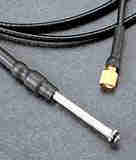The OS-418 oxygen sensor is a
miniature, Clark-type amperometric sensor that is designed for measuring static as well as
dynamically changing oxygen levels in aqueous and physiologic fluids.
General
Specifications
| Sensor Probe Length | 4.182 cm |
| Sensor Housing Length | 2.5 cm |
| Sensor Diameter | 0.318 cm |
| Sensor Housing Diameter | 0.787 cm |
| Connector Type | Modified Amphenol Sub-Minax P/N 27.9 |
Technical Specifications
| Sensor Sensitivity | 0 - 150 mm Hg |
| Response Current for Ambient pO2 | 18 nA |
| Time Constant / Response Rate (0 - 63%) | 4 s |
| Bias Voltage Required | -0.7 V |
| Thermal Drift | 4 % / °C |

- As an oxygen-level sensor in Micro-BOD (Biological Oxygen Demand) measurements.
- In monitoring oxygen levels in cell cultures.
Using a constant voltage source (potentiostat, OSI-1 or OSI-2), a constant -0.7 V bias voltage is applied between both electrodes [cathode (-) and anode (+)] of the sensor. In the absence of any other oxidizable species (and there should not be any in aq. KCl), this results in a current that is directly proportional to the RATE at which molecular oxygen is electrolytically discharged at the cathode. The steady state discharge rate is dependent upon diffusion of oxygen across the polymer membrane that covers the two electrodes. If all the oxygen that arrives at the cathode is summarily discharged, then the discharge rate (current) is directly proportional to the flux (amount per unit area per unit time) of oxygen across the membrane. This flux is directly proportional to the extra-membrane concentration of dissolved oxygen. In this way the observed current is made indirectly proportional to the oxygen concentration.
1
Oxygen Sensor
5 reusable O-rings
1 Sheet of 0.001; Polyethylene Membrane
1 Membrane Installation Tool (white, cone-shaped) 1 Sensor Housing (two parts) (black
delrin)
1 Oxygen Sensor Operations Manual

Requirements
- Requires Sensor Cable Model SC9BNC (sold separately): Model SC9BNC is a flexible coaxial cable with a female Sub-Minax connector on one end (to the OS-418 oxygen sensor) and a BNC connector on the other to the OSI-2 instrument.
- Requires Oxygen Sensor Instrument Model OSI-1 (single channel) or Model OSI-2 (dual channel) (sold separately). Model OSI-1 is a single channel oxygen sensor interrogation system for use with the Model OS-418 oxygen sensor.
- For best results, the OS-418 requires thermal regulation of the test solution and electrode to avoid appreciable thermal drift.